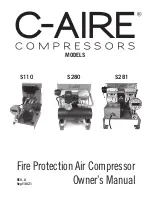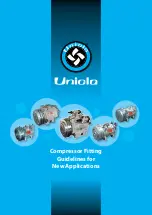
11
Deciding the best mode of operation is as simple as determining the
amount of time the compressor will be required to supply air.
If the air needed is infrequent, turn the adjustment knob on top of the
pilot valve clockwise to start/stop, this allows the compressor to start
building up pressure in the air tank and then stop when the correct
pressure is achieved, minimizing unnecessary run time and saves
energy.
When there is a frequent demand for air and/or the compressor is
located a distance from the work area, turn the adjustment knob on
top of the pilot valve counter clockwise to constant run, this allows
the compressor to constantly build up pressure in the air tank. When
pressure reaches the preset level, pressure will bleed through the
pilot valve. This minimizes the number of times the motor must start
in an hour, ensuring good motor life.
AIR COMPRESSOR PUMP
The pump compresses air into the air tank. Working air is not
available until the compressor has raised the air tank pressure above
that required at the air outlet.
MOTOR OVERLOAD PROTECTOR
The motor has a thermal overload protector.
N
If the motor overheats for any reason, the
overload protector will shut off the motor. The
motor must be allowed to cool down before
restarting. To restart:
1. Set the Auto/Off switch to OFF (O)
and unplug unit.
2. Allow the motor to cool.
3. Depress the red reset button (N) on the motor.
4. Plug the power cord into the correct branch circuit receptacle.
5. Set the Auto/Off switch to AUTO (-).
INSTALLATION
Assembly (Fig. 1)
Unpack the air compressor. Inspect the unit for damage. If the
unit has been damaged in transit, contact the carrier and
complete a damage claim. Do this immediately because there are
time limitations to damage claims.
The carton should contain:
•
air compressor
•
operator and parts manuals
Check the compressor’s serial label to ensure that you have
received the model ordered, and that it has the required pressure
rating for its intended use.
INSTALLING HOSES
WARNING:
Risk of unsafe operation. Firmly grasp hose in hand
when installing or disconnecting to prevent hose whip.
1. Ensure regulated pressure gauge reads 0 psi.
2. Apply sealant tape to hose threads.
3. Assemble hose to air outlet (F).
IMPORTANT:
Do not assemble
splitters directly to the air outlet (F).
NOTE:
Assembling quick connect bodies (L) to air outlet (F)
and quick connect plugs to hose ends make connecting and
disconnecting hoses simple and easy. Quick connect bodies and
plugs are available for purchase from your local dealer or authorized
service center.
DISCONNECTING HOSES
WARNING:
Risk of unsafe operation. Firmly grasp hose in hand
when installing or disconnecting to prevent hose whip.
1. Ensure regulated pressure gauge reads 0 psi.
2. Remove hose from air outlet (F).












































